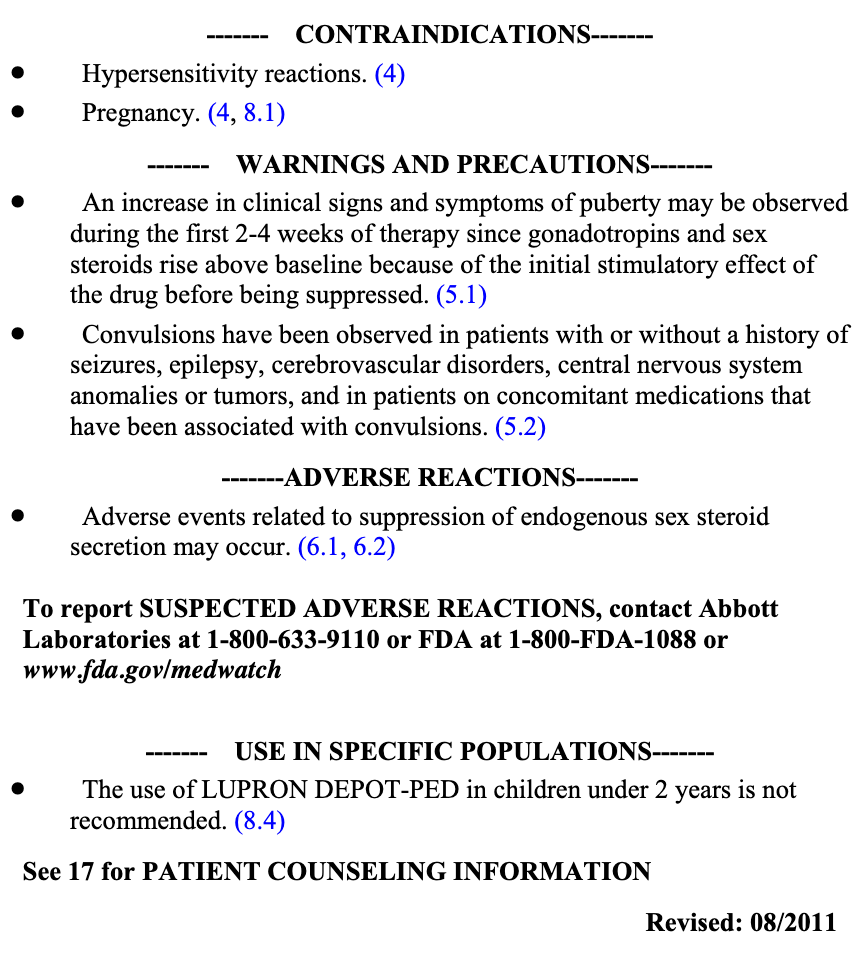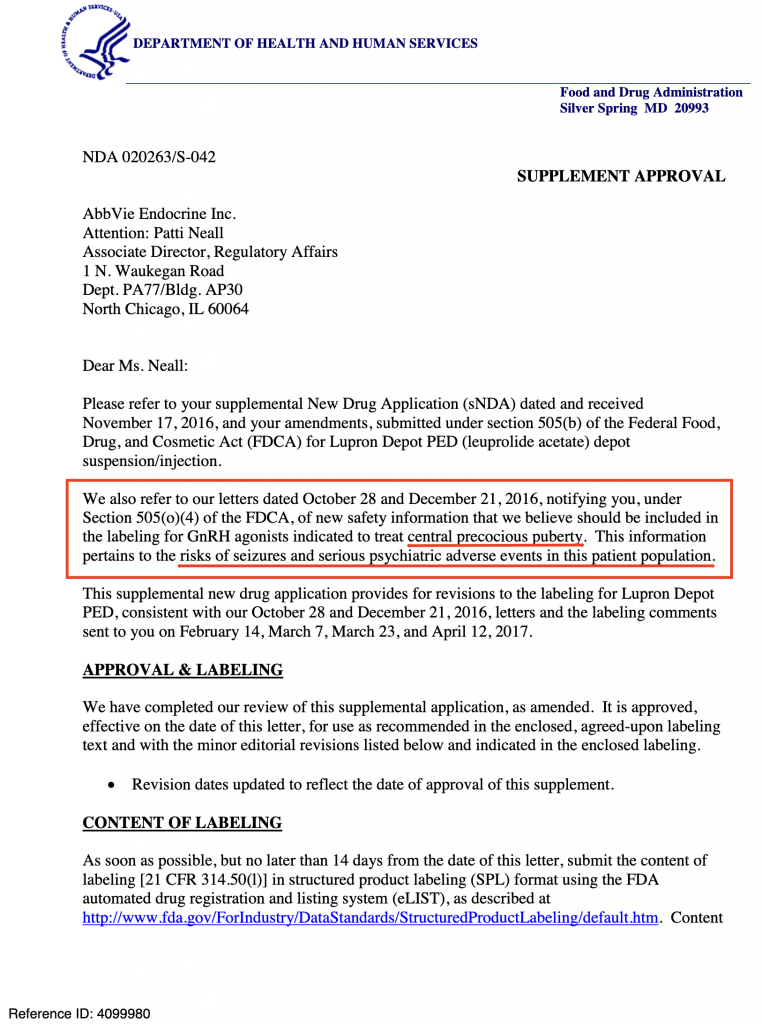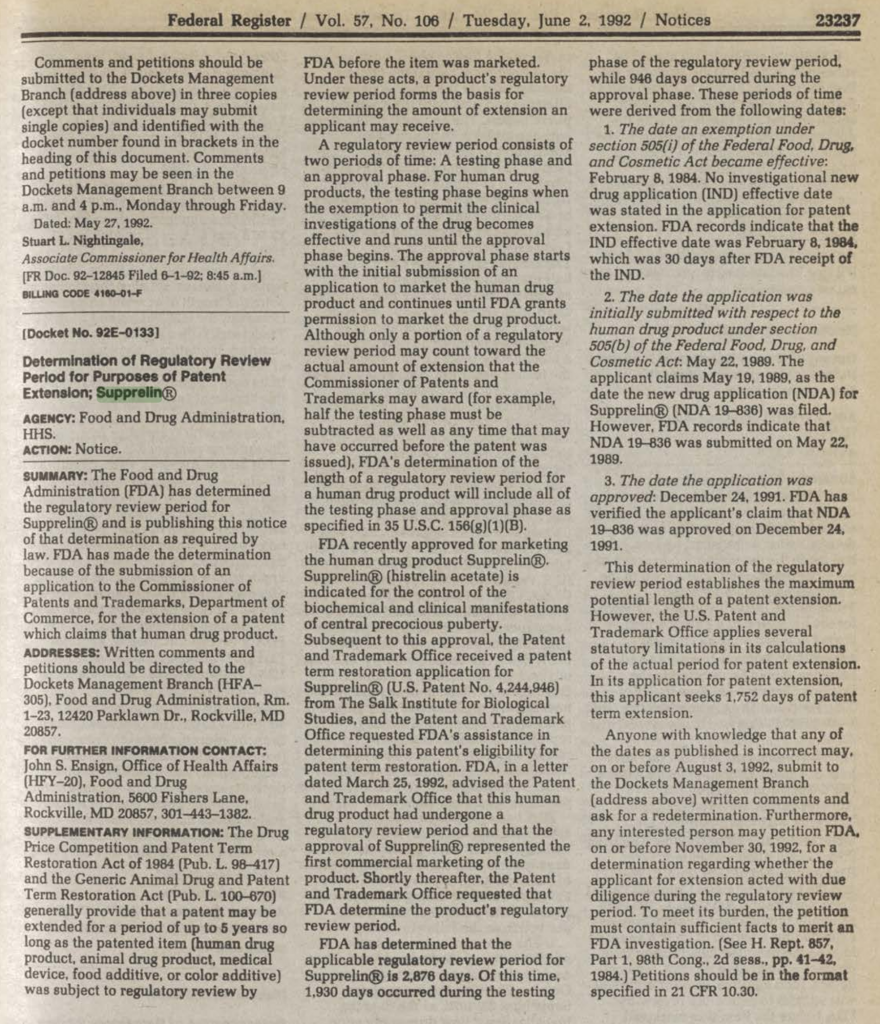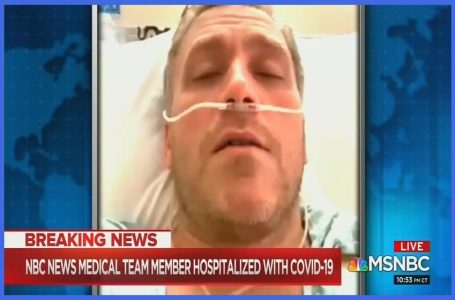Exploiting Transgenders Part 2: Medical Engineering Origins

The manufacturing of an industry by those exploiting transgenders, far exceeds what most could have conjured up in their wildest imagination. A historical timeline and the social engineering is detailed in part one of this report, and is absolutely mandatory reading before continuing below. What is happening in our country and all around the world has already crossed into dangerous territory, with children as their target. This is a billion dollar industry growing at rapid pace, and if people don’t see the writing on the wall, there is no turning back.
Puberty blockers are being used by physicians around the globe to transition children, which can lead to chemical castration and sterilization as well as a myriad of other side effects. This is the precursor to moving toward gender reassignment surgery. Where did these puberty blockers originate from, are they FDA licensed, and how did science play their role in this?
Dr. Paul McHugh, a distinguished professor of psychiatry and behavioral sciences at Johns Hopkins University, recently told the College Fix:
“Many people are doing what amounts to an experiment on these young people without telling them it’s an experiment. You need evidence for that and this is a very serious treatment. It is comparable to doing frontal lobotomies.
I believe it will be something like how we think of eugenics now. We will come to regret it when we discover how many of the young people that were injured regret it themselves.”
Medical Engineering Origins
In 1969, Marshall and Tanner published the results of their study of 192 white British girls. They claimed that the average age of thelarche (onset of secondary breast development, whereas the initial growth occurs in fetal development) was eleven years and they defined “precocious puberty” in girls if this began before age eight. For boys, it’s if pubertal development occurs before age 9. What does this effect? Primarily, ones height. They could have a growth spurt to grow taller more quickly, then it stops, so when full grown they may be on the shorter side. It certainly wouldn’t put them out of the “norm,” but they’ve programmed a society based on vanity, so being slightly shorter is unacceptable. With girls, they may begin to develop breasts a few years earlier than their friends. With boys, their penis may begin to grow slightly faster than the average boy. In all cases, NONE of this has a negative health impact on the child. It doesn’t physically harm them, their organs, their bones, or their tissue. It comes down to vanity. Being as 1 in 5,000 – 10,000 children allegedly have “central precocious puberty,” it would seem that society would look upon this as “normal,” especially considering there are a lot of fairly short people in this world. Who really cares? They do, because they can monopolize on it, by suggesting it is a disorder. What happened next?
Immediately, scientists set out to find the genes to prevent this from happening. Miraculously, just two years later, in 1971, there was a discovery and synthesis of gonadotropin-releasing hormone (GnRH) by two research teams, Andrew Shally of the New Orleans Institute Laboratory, and Roger Guillemin from the Salk Institute in California. They devised analogs that led to a Nobel Prize in 1977. This is what is used for puberty blockers, under the guise of a “disorder,” so it could be used for transgender transitioning in the future.
Sound Crazy? This is How The Mayo Clinic Depicts “Central Precocious Puberty:”
Precocious puberty signs and symptoms include development of the following before age 8 in girls and before age 9 in boys.
Symptoms
- Breast growth and first period in girls
- Enlarged testicles and penis, facial hair and deepening voice in boys
- Pubic or underarm hair
- Rapid growth
- Acne
- Adult body odor
When to see a doctor: Make an appointment with your child’s doctor for an evaluation if your child has any of the signs or symptoms of precocious puberty.
There is “central precocious puberty” and “peripheral precocious puberty.” The difference is, if it’s central, puberty starts too soon, but the majority of children have no medical problem and no identifiable reason for early puberty, whereas with peripheral, it is caused by estrogen or testosterone in the child’s body. Of course, they toss in extremely rare medical conditions that are separate issues that require treatment of their own, and could possibly be the culprit for why a child may be displaying signs of “precocious puberty.” They list horrifying, scary “rare causes” such as; a tumor in the brain or spinal cord, radiation to the brain, injury to the brain or spinal cord, exposure to external estrogen or testosterone, McCune-Albright syndrome, and ovarian cysts or tumors, which would make any parent want to rush their child to the hospital upon seeing an unusual growth of acne on their face, right?
Here is what they indicate to be the “complications” if a child has this “problem.”
Complications
• Short height. Children with precocious puberty may grow quickly at first and be tall, compared with their peers. But, because their bones mature more quickly than normal, they often stop growing earlier than usual. This can cause them to be shorter than average as adults. Early treatment of precocious puberty, especially when it occurs in very young children, can help them grow taller than they would without treatment.
• Social and emotional problems. Girls and boys who begin puberty long before their peers may be extremely self-conscious about the changes occurring in their bodies. This may affect self-esteem and increase the risk of depression or substance abuse.
So in short (no pun intended), all of this hoopla over CPP was to make parents feel that their children would feel inferior unless the parents stepped in and got treatment for this “problem.” ABSURD! Instead of letting the body take it’s natural course, they are suggesting that parents are incapable of raising their children with self-esteem, and this is because the health industry and agenda pushers have done everything they can to break down the family unit. They want you reliant on them. The health industry has long created labels for alleged problems and disorders to line their pockets, while shaming society into keeping quiet about their newly-found disorder that makes them a “broken” person and a “victim.” Instead of everyone simply accepting we are all different, with varying heights, color, and features, they have programmed society to feel inferior so they can come to the rescue with their “cures.”
How much do these potential future complications cost to diagnose? They would like to do a physical exam, hormone tests, blood samples, possible thyroid testing, an MRI, x-rays and ultrasounds. Once they assess that your child has CPP, they want to do a monthly injection into their muscle, using puberty blockers such as Lupron Depot-Ped (approved since 1993) or Trelstar (just approved in 2017) until your child reaches the normal age of puberty.
How much do these treatments cost? A lot! The monthly injections run over $1500 a month. Mind you, puberty blockers for CPP is often covered by insurance, only they are now being used on children for transitioning purposes, which may or may not be approved by insurance. If a parent prefers their child to get the Supprelin LA subcutaneous implant that is surgically placed under their skin, for a 12-month period, that could run them as much as $39,000 according to Drugs.com.
What are the side effects to these puberty blockers? Let’s look at Lupron Depot-Ped as an example, since they claim to be the number one prescribed treatment for CPP. In 2011, they listed few side effects on their label, approved by the FDA.

In 2016, the FDA required changes to their warning labels.

Lupron wasn’t the only medication that was required to update their warning labels due to seizures and serious psychiatric adverse events. Supprelin and Synarel were also required to make these updates. In this 109-page approval package for Lupron Depot PED, they repeatedly state that the medicine is for children with “central precocious puberty.” The FDA and Department of Health and Human Services also state this. Nowhere in any of their documentation or FDA approvals does it state this medicine can be used in children to block their puberty for purposes of transitioning their gender. Even though “central precocious puberty” is a manufactured “disorder,” it still limits the use to those purposes. With the dangers these medications present, why isn’t the FDA stepping in? Better yet, why isn’t the Bureau of Consumer Protection under the FTC knocking down doors of these clinics, hospitals, and universities for false advertising and marketing, and clear misuse of these products? I’ve seen them knock down doors for a fraction of the manipulation game these folks are running. Yet, they are silent.

The full breakdown of warnings and precautions include:
• Psychiatric events of emotional lability, crying, irritability, impatience, anger, and aggression.
• Convulsions in patients with and without a history of seizures, epilepsy, cerebrovascular disorders, central nervous system anomalies or tumors.
• Injection site reactions and pain including abscess, headache, emotional lability, and hot flushes/sweating.
• Early phase of therapy can cause an increase in clinical signs and symptoms of puberty.
• In less than 2% of patients receiving treatment, adverse reactions of a broad scope of symptoms were reported, either effecting the respiratory system, cardiovascular, endocrine, musculoskeletal, skin and appendages, and urogenital system.
According to a 2019 investigation by ABC’s KTNV 13 Las Vegas, there are over 25,000 adverse reports including 1500 deaths on Lupron products for puberty blockers, endometriosis, and prostate cancer.
The ultimate question – as a parent, what do you feel is more dangerous? The “risk” of your child going through puberty a little earlier than the other children, potentially resulting in feeling self-conscious and possibly being shorter in height, or the “risks” listed above?
According to Drs. Paul Hruz, Michael Laidlaw and Quentin Van Meter, not only are they injecting Lupron into children who suffer from gender dysphoria, which has never been approved by the FDA for this use, there are no peer-reviewed studies done on the drug’s long-term physical and psychological side effects on children. It’s no wonder suicidal thoughts and actions are so high in the transgender community. These drugs not only come with serious side effects with lasting health problems, they can also lead to sterilization.
Despite this, physicians have been pushing for this for quite some time. In 1983, Walt Heyer, who was a transgender woman for eight years, who later detransitioned after realizing that the sex change didn’t solve his underlying issues, had sought out the top gender identity therapist of his time only to be told that he needed to go through gender reassignment during his first appointment, and was given a prescription for hormones at his second appointment. This is incredibly telling, when the tops doctors, all the way back in the 80s, were pushing for this, without even attempting to address traumas, unresolved issues, and why it is they may be suffering from gender dysphoria. This also aligns with the agenda timeline documented in part one of this report. Heyer was an adult at that time, whereas now days, they are pushing this onto children as well.
Dr. Paul McHugh, a distinguished professor of psychiatry and behavioral sciences at Johns Hopkins University, recently told The College Fix he believes transgender people are being experimented on because the doctors treating their patients with hormones “don’t have evidence that the treatment will be the right one.” He went on to state:
Many people are doing what amounts to an experiment on these young people without telling them it’s an experiment. You need evidence for that and this is a very serious treatment. It is comparable to doing frontal lobotomies.
I think their mental problems, often depression, discouragement are the things that need treatment. I’m not positive about this. It’s a hypothesis, but it is a very plausible hypothesis, and it would explain why many of the people who go on to have treatment of their body discover they are just as depressed, discouraged and live just as problematic lives as they did before because they did not address the primary problem.
They’re going to be in the hands of doctors for the rest of their lives, many of them are going to be sterilized not able to have their own children, and many will regret this. Can you imagine having a life where you need to seek doctors all the time, for everything, just to live? Getting your hormones checked, getting everything checked. That is something doctors should like to spare people of.
I believe it will be something like how we think of eugenics now. We will come to regret it when we discover how many of the young people that were injured regret it themselves.
Johns Hopkins was at the forefront of this manufactured industry, and for this professor to come forward and speak the truth against his own community pushing this agenda, is powerful. If only more doctors would come forward, we could turn the tide and stop the insanity. And, he is absolutely correct about eugenics. Sadly, eugenics never ceased, it merely changed terminology, and this is precisely what is taking place in this case. You can read an extensive 6-part report on eugenics right here on Corey’s Digs.
A Quick Timeline Recap & Other Key Points:
1969 – They decided children had a “disorder” and coined it “precocious puberty.”
1971 – Scientist miraculously found the solution for a cure.
In 1984, none other than the Washington Post came out with one of the most fear mongering stories of all about an “affliction” to the young through an “outbreak” in Puerto Rico, where one child began menstruating at 17 months and a “9-year old boy’s estrogen levels exceeded that of an ovulating woman.” They estimated 3,000 children were “affected” by precocious puberty, but that in the United States and other countries, “this condition is rare.” Fast forward 35 years and they now claim that 1 in 5,000 to 10,000 children have CPP, while also stating it is rare and effects less than 1% of the U.S. population.
Puerto Rican doctors suspected a possible estrogen in the food chain causing this or an environmental contaminant. Imagine that. The director of pediatrics at Hospital De Diego in San Juan expressed that he had encountered the condition in the mid 1970s and had seen 778 affected children, most in between 1982 and 1984. After investigations, they determined there were high levels of estrogen in the poultry, only later to disprove their own findings by further chemical tests. An endocrinologist in Philadelphia ran tests and did find high levels of estrogen in the poultry. The USDA ended up sampling poultry, beef and eggs only to find they were not contaminated with estrogen, so they said. It then went to the CDC, where they ran statistical analysis on 130 cases of females that had been affected. Yet, after two years they had no conclusions. Of course in this story, they portrayed the stress of a mother whose daughter had cysts and enlarged breast tissue, which is its own separate issue that they attribute as a potential cause of CPP.
That was a big, bold push to bring awareness to this newly discovered “precocious puberty disorder.”
1989 – Patent for Supprelin was filed in May by The Salk Institute, which is a histrelin acetate injectable puberty blocker for children with “central precocious puberty.”
1991 – Supprelin was approved by the FDA on December 24th as the first product of its kind. However, Johnson & Johnson’s were the pharmaceutical company selling it.

1993 – The FDA approved Lupron Depot-Ped for CPP. In 1993, when Abbott Laboratories (now AbbVie) sought to get their FDA license to utilize Lupron in children for CPP, an abstract was published on trials they had done on just 10 girls at Children’s Hospital in Phoenix, AZ, to determine the efficacy and long-term effects. They ran this study on 10 girls and “Patients who finished treatment have been followed up for up to 5 years, and will continue in follow-up throughout their reproductive life.”
2007 – Supprelin-(R)-LA was approved by the FDA. Rather than being an injectable puberty blocker like their method designed in 1989, this is a subcutaneous implant that is inserted into the upper arm for a continuous release over a 12 month period.
2008 – The Endocrine Society, with members in more than 100 countries, “approved” puberty suppressors as a treatment for transgender adolescents as young as 12 years old. It has never been licensed by the FDA for this purpose.
2011 – The World Professional Association for Transgender Health (WPATH) issued “standards of care” for the treatment of patients with gender dysphoria, including puberty suppression.
WPATH was originally called the Henry Benjamin International Gender Dysphoria Association.
2014 – Government appeals board ruled that Medicare must cover surgery for gender transitions, which overturned a policy dating back to the 1980s. WPATH standards of care studies on the benefits of sex reassignment therapy played a big role in this. It doesn’t mean all sex reassignment surgeries will be paid for by Medicare, but it lifted the ban so they can submit documentation for coverage. Between 2000 – 2014, surgeries increased four-fold.
2016 – The FDA requires all manufacturers of puberty blockers to add “risk of seizures and serious psychiatric adverse events in this patient population” to their safety warning labels.
2019 – The Hill reported in October, “a federal judge overturned ObamaCare protections for transgender patients, ruling that a 2016 policy violates the religious freedom of Christian providers. The regulation prohibited insurers and providers who receive federal money from denying treatment or coverage to anyone based on sex, gender identity or termination of pregnancy. It also required doctors and hospitals to provide “medically necessary” services to transgender individuals as long as those services were the same ones provided to other patients.”
Big Business
Gender affirming hormone therapy is big business. In fact, it’s so big, Planned Parenthood has quickly climbed to be the nation’s second largest provider. Whereas nearly all, if not all, of their centers provide this service to those who are 18 years or older, some of them also provide prescriptions for puberty blockers. They do all of this under the guise of “reproductive rights.” More on this in part 3.
In addition to hormone therapy, surgeries for breast augmentation and reassignment surgery have skyrocketed. When I stated that they have manufactured an industry, I wasn’t hypothesizing. This is a huge market, with many funders, many profiteers, and a whole lot of dancing and shaking of hands taking place. They have taken advantage of, and completely exploited the transgender community. While portraying to show their support, what they are really doing is backing their agenda, which is to destabilize countries and turn them into a socialist one world governance, experiment on humans while sterilizing them through hormones and surgery, and make themselves incredibly wealthy in the process to keep their agenda moving forward.
Does anyone really believe they would have dedicated this much time, energy and money into less than 1% of the population for well over seven decades, if they didn’t believe they could increase that 1% and monetize it while changing the fabric of our world forever? Part 3 will get into the funders and profiteers. Stay tuned.
Part 3 coming soon!
Exploiting Transgenders Part 3: The Funders & Profiteers
The post Exploiting Transgenders Part 2: Medical Engineering Origins appeared first on coreysdigs.com.
















